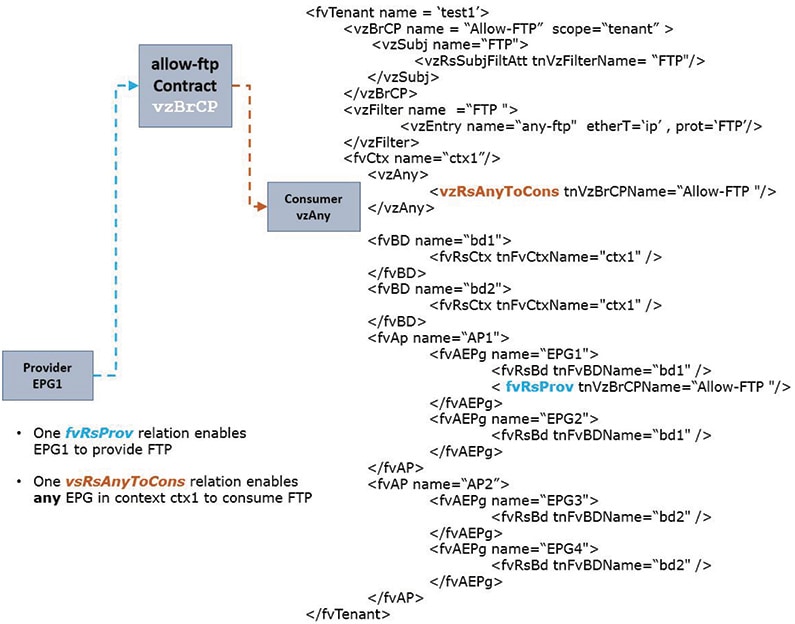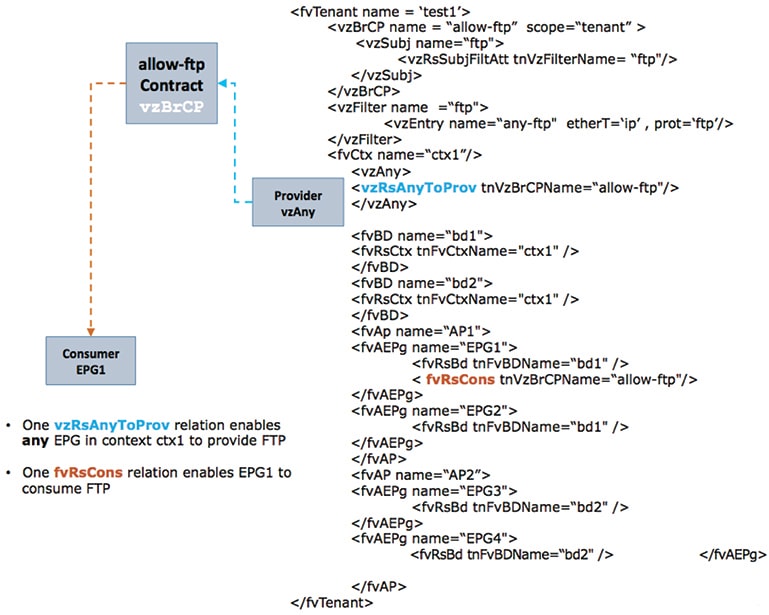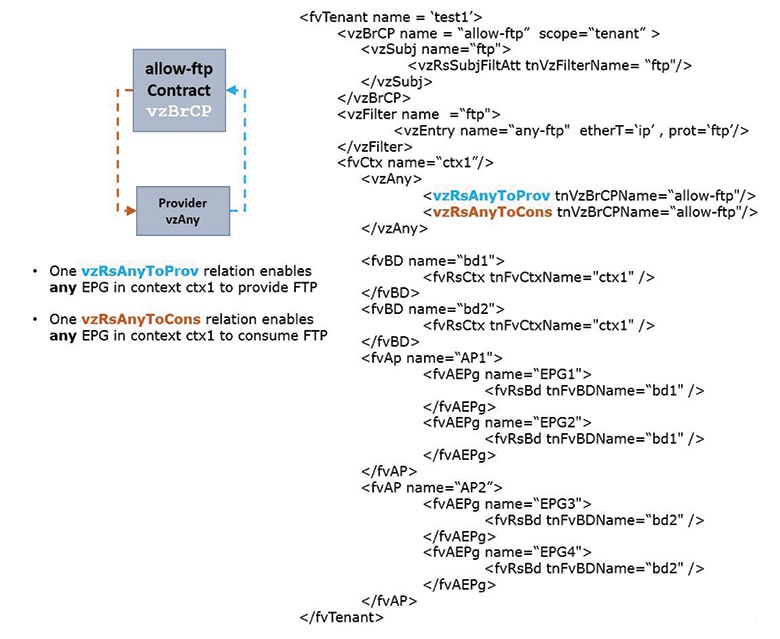New and Changed Information
|
Cisco APIC Release Version |
Feature |
Description |
What Changed |
|---|---|---|---|
|
Release 2.2(1n) |
Preferred Group Member |
Support for |
-- |
|
Release 1.0(1e) |
This feature was introduced. |
-- |
-- |
What vzAny Is
The vzAny managed object provides a convenient way of associating all endpoint groups (EPGs) in a Virtual Routing and Forwarding (VRF)
instance to one or more contracts (vzBrCP), instead of creating a separate contract relation for each EPG.
In the Cisco ACI fabric, EPGs can only communicate with other EPGs according to contract rules. A relationship between an
EPG and a contract specifies whether the EPG provides the communications defined by the contract rules, consumes them, or
both. By dynamically applying contract rules to all EPGs in a VRF, vzAny automates the process of configuring EPG contract relationships. Whenever a new EPG is added to a VRF, vzAny contract rules
automatically apply. The vzAny one-to-all EPG relationship is the most efficient way of applying contract rules to all EPGs in a VRF.
 Note |
In the APIC GUI under tenants, a VRF is also known as a private network (a network within a tenant) or a context. |
In the case of shared services, you must define the provider EPG shared subnet under the EPG in order to properly derive the pcTag (classification) of the destination from the consumer (vzAny) side. If you are migrating from a BD-to-BD shared services configuration, where both the consumer and provider subnets are defined under bridge domains, to vzAny acting as a shared service consumer, you must take an extra configuration step where you add the provider subnet to the EPG with the shared flags at minimum.
 Note |
If you add the EPG subnet as a duplicate of the defined BD subnet, ensure that both definitions of the subnet always have the same flags defined. Failure to do so can result in unexpected fabric forwarding behavior. |
To use vzAny, navigate to .
How vzAny Works
The following scenarios illustrate how vzAny works:
-
EPG contract provider and consumer relations without using vzAny
-
vzAnyis the consumer and one EPG is the provider -
vzAnyis the provider and one EPG is the consumer -
vzAnyis the provider and the consumer




While these scenarios illustrate very simple configurations, large production systems can easily have thousands of contract relationships in a single VRF. In such cases, vzAny could eliminate half or more of the contract relationships. This simplification not only makes the configuration much easier to maintain but can also save on switch TCAM buffer consumption.
vzAny Guidelines and Limitations
Observe the following guidelines when using vzAny:
-
All EPGs in a VRF can take the role of a provider, a consumer, or both depending on the configuration.
-
In addition to application profile EPGs,
vzAnyproviders and consumers include external EPGs such asl2extOutandl3extOut, and endpoint groups for out-of-band (mgmtOoB) or in-band (mgmtInB) access. -
vzAnyis supported as a consumer of a shared service but is not supported as a provider of a shared service. -
vzAnyimplicitly permits all subnets. WhenvzAnyis in use for a VRF, it also includes the L3out, hence it is equivalent to having created a L3external classification that includes the subnets specified in the VRF itself. -
If an EPG, within a VRF, is consuming a shared service contract from an EPG of a different VRF (that we call provider VRF), the traffic from the EPG of the provider VRF is filtered within the consumer VRF.
vzAnyis equivalent to a wildcard for the source or destination EPG. Be careful when you configure a contract with avzAnyin the consumer VRF because the vzAny contracts may also apply to the traffic between the EPG of the provider VRF and the EPG of the consumer VRF.
Note
Failure to observe this guideline could allow unintended traffic between EPGs across VRFs.
-
Configuring a VRF with
vzAnyas both the provider and the consumer, and with the defaultallow allfilter, is the same as configuring anunenforcedVRF. TheunenforcedVRF is a simpler configuration that produces the same result. In addition, all EPGs within that VRF are free to communicate to each other without a contract. IfvzAnyis marked as a Preferred Group Member, only those EPGs marked as a Preferred Group Member will be able to communicate with each other without a contract. Alternatively, any EPG, within that VRF that is not marked as a Preferred Group Member, will be unable to communicate without a contract
Note
It is not recommended to enable Preferred Group Member (marked as Include) for vzAny when configuring a VRF with
vzAnyas both the provider and the consumer, and with the defaultallow allfilter, due to it then disables the ability for all EPGs within that VRF to communicate without a contract.
-
If the contract scope is
application-profile, thevzAnyconfiguration is ignored and filter rules are expanded; CAM utilization is the same as if specific consumers and providers are deployed. In this case, there is no saving in CAM usage. -
Since
vzAnydynamically enables its contract rules for any current or future EPG in a VRF, good practice is to document such configurations. -
In the case of shared services using inter-VRF contracts, you must define the provider EPG shared subnet under the EPG in order to properly derive the pcTag (classification) of the destination from the consumer (vzAny) side. If you are migrating from a BD-to-BD shared services configuration, where both the consumer and provider subnets are defined under bridge domains, to vzAny acting as a shared service consumer, you must take an extra configuration step where you add the provider subnet to the EPG with the shared flags at minimum.

Note
For inter-VRF contracts, if you add the EPG subnet as a duplicate of the defined BD subnet, ensure that both definitions of the subnet always have the same flags defined. Failure to do so can result in unexpected fabric forwarding behavior.
 Feedback
Feedback